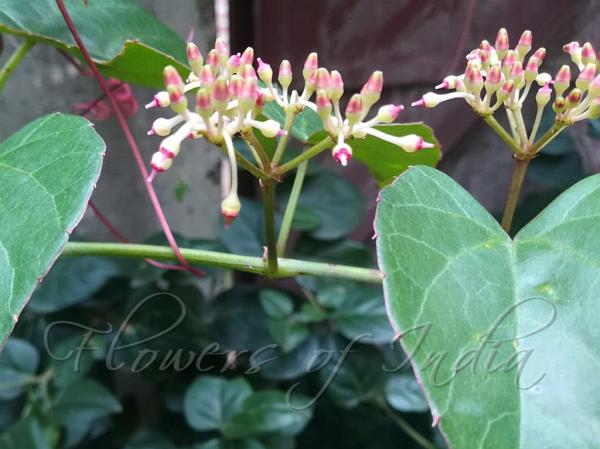|
| Entire-Leaf Wild Grape |
|

|

|
|
|
|
Photo: |
Botanical name: Cissus adnata Family: Vitaceae (Grape family)
Synonyms: Vitis adnata, Cissus compressa, Cissus compressa
Synonyms: Vitis adnata, Cissus compressa, Cissus compressa
Entire-Leaf Wild Grape is a deciduous, slender,
climbing shrub producing stems 5-15 m long. Flowers are borne in
umbels, leaf-opposed; on flower-cluster-stalk 1.5-4.5 cm, with dense
rusty curly hairs. Flower-stalks are 1.5-2.5 mm, velvet-hairy. Buds
oval, 1.5-2 mm, tip rounded or blunt. Calyx is wavily lobed,
velvet-hairy. Petals are oval, 1.3-1.7 mm, velvet-hairy. Flowers are
4-merous. Petals are distinct, greenish-yellow, less than 1 mm long,
oblong-ovate, hooded, velvet-hairy outside ; style columnar. Ovary is
sparsely hairy; style conical; stigma expanded. The stems either
scramble over the ground or climb into surrounding vegetation for
support, attaching themselves by means of tendrils. Branchlets are
round, with longitudinal ridges, with dense rubiginous curly hairs;
tendrils bifurcate. Leaves are simple, both surfaces of same color when
dry; leaf-stalk 1.5-7 cm, densely rusty hairy; leaf blade
heart-shaped-oval, 6-11.5 x 5.5-8.5 cm, below with dense rusty curly
hairs, above velvet-hairy when young, then hairs falling off and with
some hairs only on veins, basal veins 3-5, lateral veins 5 or 6 pairs,
base heart-shaped, notch rounded or blunt and angular, margin with
35-40 sharp teeth on each side, tip with a short sharp point, rarely
pointed. Berry is 6-7 × 5-6 mm, 1-seeded. Seed surface with sharp
ridges, ventral holes short and narrow. Leaves are boiled and eaten in
NE India. Entire-Leaf Wild Grape is found in the Himalaya, from
Garhwal to NE India, South India, Ceylon, Malaysia, at altitudes of
800-1100 m. In South India it is found in Western Ghats and Nilgiri
hills. Flowering: June-July.
Medicinal uses: Boiled extract of leaves is
used in urinary track infection due to stone. Applied to bone fracture.
Tuber decoction is blood purifier. Powdered roots are antisceptic,
applied to cuts and wounds.
Boiled extract of leaves is
used in urinary track infection due to stone. Applied to bone fracture.
Tuber decoction is blood purifier. Powdered roots are antisceptic,
applied to cuts and wounds.
Medicinal uses:
 Boiled extract of leaves is
used in urinary track infection due to stone. Applied to bone fracture.
Tuber decoction is blood purifier. Powdered roots are antisceptic,
applied to cuts and wounds.
Boiled extract of leaves is
used in urinary track infection due to stone. Applied to bone fracture.
Tuber decoction is blood purifier. Powdered roots are antisceptic,
applied to cuts and wounds. | Identification credit: Thingnam Sophia | Photographed in Imphal, Manipur. |
• Is this flower misidentified? If yes,